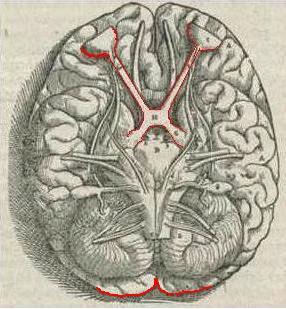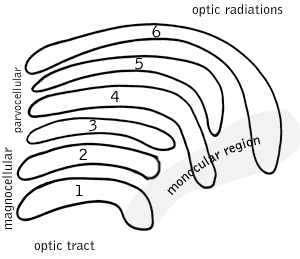Visual system
The visual system is the part of the nervous system which allows organisms to see. It interprets the information from visible light to build a representation of the world surrounding the body. The visual system has the complex task of (re)constructing a three dimensional world from a two dimensional projection of that world. The psychological manifestation of visual information is known as visual perception.
Introduction
This article mostly describes the visual system of mammals, although other "higher" animals have similar visual systems. In this case, the visual system consists of:
- The eye, especially the retina
- The optic nerve
- The optic chiasm
- The optic tract
- The lateral geniculate nucleus
- The optic radiation
- The visual cortex
Different species are able to see different parts of the light spectrum; for example, bees can see into the ultraviolet,[1] while pit vipers can accurately target prey with their infrared imaging sensors.[2]
 The image projected onto the retina is inverted due to the optics of the eye. |
Eye
The eye is a complex biological device. The functioning of a camera is often compared with the workings of the eye, mostly since both focus light from external objects in the visual field onto a light-sensitive medium. In the case of the camera, this medium is film or an electronic sensor; in the case of the eye, it is an array of visual receptors. With this simple geometrical similarity, based on the laws of optics, the eye functions as a transducer, as does a CCD camera.
Light entering the eye is refracted as it passes through the cornea. It then passes through the pupil (controlled by the iris) and is further refracted by the lens. The cornea and lens act together as a compound lens to project an inverted image onto the retina.

Retina
The retina consists of a large number of photoreceptor cells which contain a particular protein molecule called an opsin. In humans, there are two types of opsins, rod opsins and cone opsins. Either opsin absorbs a photon (a particle of light) and transmits a signal to the cell through a signal transduction pathway, resulting in hyperpolarization of the photoreceptor. (For more information, see photoreceptor).
Rods and cones differ in function. Rods are found primarily in the periphery of the retina and are used to see at low levels of light. Cones are found primarily in the center (or fovea) of the retina. There are three types of cones that differ in the wavelengths of light they absorb; they are usually called short or blue, middle or green, and long or red. Cones are used primarily to distinguish color and other features of the visual world at normal levels of light.
In the retina, the photoreceptors synapse directly onto bipolar cells, which in turn synapse onto ganglion cells of the outermost layer, who will then conduct action potentials to the brain. A significant amount of visual processing arises from the patterns of communication between neurons in the retina. About 130 million photoreceptors absorb light, yet roughly 1.2 million axons of ganglion cells transmit information from the retina to the brain. The processing in the retina includes the formation of center-surround receptive fields of bipolar and ganglion cells in the retina, as well as convergence and divergence from photoreceptor to bipolar cell. In addition, other neurons in the retina, particularly horizontal and amacrine cells, transmit information laterally (from a neuron in one layer to an adjacent neuron in the same layer), resulting in more complex receptive fields that can be either indifferent to color and sensitive to motion or sensitive to color and indifferent to motion.
The final result of all this processing is five different populations of ganglion cells that send information to the brain: M cells, with large center-surround receptive fields that are sensitive to depth, indifferent to color, and rapidly adapt to a stimulus; P cells, with smaller center-surround receptive fields that are sensitive to color and shape; K cells, with very large center-only receptive fields that are sensitive to color and indifferent to shape or depth; another population that is intrinsically photosensitive; and a final population that is used for eye movements.
A 2006 University of Pennsylvania study calculated the approximate bandwidth of human retinas to be about 8960 kilobits per second, whereas guinea pig retinas transfer at about 875 kilobits. [3]
Photochemistry
In the visual system, retinal, technically called retinene1 or "retinaldehyde", is a light-sensitive retinene molecule found in the photoreceptor cells of the retina. Retinal is the fundamental structure involved in the transduction of light into visual signals, i.e. nerve impulses in the ocular system of the central nervous system. In the presence of light, the retinal molecule changes configuration and as a result a nerve impulse is generated.
Fibers to thalamus
Optic nerve

The information about the image via the eye is transmitted to the brain along the optic nerve. Different populations of ganglion cells in the retina send information to the brain through the optic nerve. About 90% of the axons in the optic nerve go to the lateral geniculate nucleus in the thalamus. These axons originate from the M, P, and K ganglion cells in the retina. This parallel processing is important for reconstructing the visual world; each type of information will go through a different route to perception. Another population sends information to both the superior colliculus in the midbrain, which assists in controlling eye movements (saccades).[4]
A final population of photosensitive ganglion cells (containing melanopsin) sends information to the pretectum (pupillary reflex), and to several structures involved in the control of circadian rhythms and sleep such as the suprachiasmatic nucleus (SCN, the biological clock), the ventrolateral preoptic nucleus (VLPO, a region involved in sleep regulation).[5]
Optic chiasm
The optic nerves from both eyes meet and cross at the optic chiasm, at the base of the hypothalamus of the brain. At this point the information coming from both eyes is combined and then splits according to the visual field. The corresponding halves of the field of view (right and left) are sent to the left and right halves of the brain, respectively, to be processed. That is, the right side of primary visual cortex deals with the left half of the field of view from both eyes, and similarly for the left brain.[4] A small region in the center of the field of view is processed redundantly by both halves of the brain.
Optic tract
Information from the right visual field (now on the left side of the brain) travels in the left optic tract. Information from the left visual field travels in the right optic tract. Each optic tract terminates in the lateral geniculate nucleus (LGN) in the thalamus.

Lateral geniculate nucleus
The lateral geniculate nucleus (LGN) is a sensory relay nucleus in the thalamus of the brain. The LGN consists of six layers in humans and other primates starting from catarhinians, including cercopithecidae and apes. Layers 1, 4, and 6 correspond to information from one eye; layers 2, 3, and 5 correspond to information from the other eye. Layer one (1) contains M cells, which correspond to the M (magnocellular) cells of the optic nerve of the opposite eye, and are concerned with depth or motion. Layers four and six (4 & 6) of the LGN also connect to the opposite eye, but to the P cells (color and edges) of the optic nerve. By contrast, layers two, three and five (2, 3, & 5) of the LGN connect to the M cells and P (parvocellular) cells of the optic nerve for the same side of the brain as its respective LGN. The six layers of the LGN are the area of a credit card, but about three times the thickness of a credit card, rolled up into two ellipsoids about the size and shape of two small birds eggs. In between the six layers are smaller cells that receive information from the K cells (color) in the retina. The neurons of the LGN then relay the visual image to the primary visual cortex (V1) which is located at the back of the brain (caudal end) in the occipital lobe in and close to the calcarine sulcus.

Optic radiation
The optic radiations carries information from the thalamic lateral geniculate nucleus to layer 4 of the visual cortex. The P layer neurons of the LGN relay to V1 layer 4C β. The M layer neurons relay to V1 layer 4C α. The K layer neurons in the LGN relay to large neurons called blobs in layers 2 and 3 of V1.
There is a direct correspondence from an angular position in the field of view of the eye, all the way through the optic tract to a nerve position in V1. At this juncture in V1, the image path ceases to be straightforward; there is more cross-connection within the visual cortex.
Visual cortex
The visual cortex is the most massive system in the human brain and is responsible for higher-level processing of the visual image. It lies at the rear of the brain (highlighted in the image), above the cerebellum. The interconnections between layers of the cortex, the thalamus, the cerebellum, the hippocampus and the remainder of the areas of the brain are under active investigation. Currently, much of what is known stems from patients with damage to known areas of the brain, with a corresponding study of the cognitive functions which have been spared. See visual modularity for a discussion of the modular thesis of visual perception.
See also
- Dorsal stream
- Echolocation
- Machine vision
- Memory-prediction framework
- Ventral stream
- Visual perception
- Visual modularity
References
- ^ J Bellingham, SE Wilkie, AG Morris, JK Bowmaker and DM Hunt (1997), "Characterisation of the ultraviolet-sensitive opsin gene in the honey bee, Apis mellifera", European Journal of Biochemistry, Vol 243, 775-781
- ^ AB Safer and MS Grace (2004), "Infrared imaging in vipers: differential responses of crotaline and viperine snakes to paired thermal targets". Behav Brain Res. 154(1):55-61. 2004 Sep 23.
- ^ http://www.newscientist.com/article/dn9633-calculating-the-speed-of-sight
- ^ a b Nolte, John (2002). The Human Brain: An Introduction to Its Functional Anatomy. 5th Ed. St. Louis: Mosby. pp. 410–447.
{{cite book}}: Cite has empty unknown parameter:|coauthors=(help) - ^ Lucas, R. J. "Diminished Pupillary Light Reflex at High Irradiances in Melanopsin-Knockout Mice". Science. 299 (5604): 245–247.
{{cite journal}}: Unknown parameter|coauthors=ignored (|author=suggested) (help)
- David H. Hubel (1989), Eye, Brain and Vision. New York: Scientific American Library.
- David Marr (1982), Vision: A Computational Investigation into the Human Representation and Processing of Visual Information. San Francisco: W. H. Freeman.
- R.W. Rodiek (1988). "The Primate Retina". Comparative Primate Biology Vol. 4 of Neurosciences. (H.D. Steklis and J. Erwin, editors.) pp. 203-278. New York: A.R. Liss.
- Matthew Schmolesky, The Primary Visual Cortex
- Martin J. Tovée (1996), An introduction to the visual system. Cambridge University Press, ISBN 0-521-48339-5 (References, pp.180-198. Index, pp.199-202. 202 pages.)
- Andreas Vesalius (1543) De Humani Corporis Fabrica (On the Workings of the Human Body)
- Torsten Wiesel and David H. Hubel (1963), "The effects of visual deprivation on the morphology and physiology of cell's lateral geniculate body". Journal of Neurophysiology 26, 978-993.
External links
- "Webvision: The Organization of the Retina and Visual System" - John Moran Eye Center at University of Utah
- VisionScience.com - An online resource for researchers in vision science.
- Journal of Vision - An online, open access journal of vision science.
- Hagfish research has found the “missing link” in the evolution of the eye. See: Nature Reviews Neuroscience.